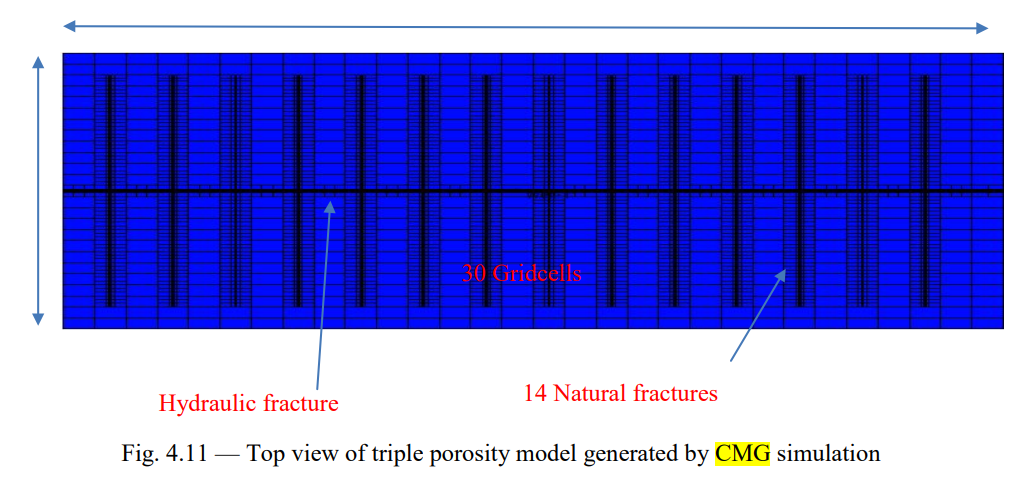NUMERICAL SIMULATION OF PRESSURE TRANSIENT PERFORMANCES IN TIGHT FORMATION AND PRODUCTION DECLINE ANALYSIS
近年来,低渗透、超低渗透致密油藏已成为北美油气供应的重要来源。致密油储层的生产和压力瞬变分析是油藏科研人员面临的最困难问题之一,因为致密地层中固有的极端复杂性,例如通常通过水力压裂改造来达到有效渗透率进行多层开采。不幸的是,有限的产能和不利的经济状况限制收集用于综合油藏研究的动态数据的投资。水平井完井和多级水力压裂技术使这类储层实现了经济生产。为了从致密地层中商业化开采油气,天然完井(裸眼)或带多级水力裂缝的套管水平井是最常用的完井方式。
多裂缝水平井的组合使用预计将产生复杂的流态序列(Chen和Raghavan,1997;Clarkson和Pederson,2010)。正确分析和识别流态的存在和出现流态的顺序,对于获得有关水力压裂优化和致密地层特征的有效信息至关重要。本文详细讨论了大型天然裂缝和均质(单一孔隙度)地层中水力压裂水平井的压力诊断图及其相应的导数响应,提供了不同现有经验速度-时间相关之间的类型曲线拟合性能,并与基于目标是萨斯喀彻温省西部的Bakken和Viking地层模拟结果进行对比。
我们考虑了一口裸眼和套管完井水平井,以及一个纵向或多个横向多个垂直于水平井水力裂缝,其被天然裂缝包围,并用双孔理想模型模拟。采用商业油藏模拟软件IMEX,根据进行压力瞬变特性和生产数据进行相关研究。IMEX是一个三维有限差分油藏模拟软件,已被石油行业广泛接受。对压力瞬态特性进行了讨论和比较。正如许多研究结果所指出,研究表明,完全填充的区域性天然裂缝将显示不同压力瞬变特征,因此对油井生产动态有很大影响。
此外,即使存在水力裂缝的情况下,这些具有传导率的的、相互连通的天然裂缝控制着致密地层中水平井的压力瞬变特征。此外,模拟运行还表明,如果储层在一定程度上存在天然裂缝,水力压裂增产可能不会显著提高产能,除非能够达到大量水力裂缝和无限导流能力。为了证明模拟模型的可行性和适用性,模拟的压力瞬态响应与广泛接受的试井模型Kappa的相应分析结果进行了代表性对比。对比讨论将基于均质储层中横向裂缝水平井的拟合性能。还提供了类型曲线拟合和预测EUR的现场案例研究。
ABSTRACT
Low to ultra-low permeability tight oil reservoirs have recently become a significant source of hydrocarbon supply in North America. Production and pressure transient analysis of tight oil reservoirs is one of the most difficult problems facing a reservoir researcher because of the extreme complexity inherent in tight formations, such as producing from multiple layers with effective permeability that is often enhanced by hydraulic fracturing. Unfortunately, limited productivity and unfavorable economics often prevent expenditures of money and time to collect the dynamic data needed for a comprehensive reservoir study. Horizontal well completion along with multi-stage hydraulic fracturing techniques has enabled economic production from these kinds of reservoirs. To produce oil and gas commercially from tight formations, naturally completed (open-holed) or cased horizontal wells with multi-stage hydraulic fractures are the most popular implementation for completion. The use of a combination of the multifractured horizontal wells is expected to create a complex sequence of flow regimes (Chen and Raghavan, 1997; Clarkson and Pederson, 2010). The proper analysis and identification of presence of flow regimes and sequence of emerging flow regimes are essential for obtaining efficient information about hydraulic fracturing optimization and the tight formation characterization.
This thesis provides a detailed discussion of diagnostic plots of pressure and its corresponding derivative responses for hydraulically fractured horizontal wells in a sizable naturally fractured and homogeneous (single-porosity) formation and providestype-curving matching performance among different existing empirical rate-time relations and compared with simulation results based on the targeted Bakken and Viking Formation in Western Saskatchewan. We consider a naturally-completed (open-hole) and cased horizontal well with either single longitudinal or multiple transverse hydraulic fractures which are normal in the horizontal wellbore, and which might be surrounded by an area with natural fracture system which is simulated by dual-porosity idealization. The discussion is based on pressure-transient performances and characteristics of production data generated by employing a commercial reservoir simulator, CMG IMEX, a 3D finite difference reservoir simulation package which is widely and popularly accepted by petroleum industry. Pressure transient features are discussed and compared. As noted by many findings, it is shown that fully-filled and regional natural fractures would display various pressure transient characteristics and, hence, considerably affects well production performance. In addition, these conductive, interconnected natural fractures dominate the pressure transient performances of horizontal wells in tight formations even with the presence of hydraulic fractures. Additionally, the simulation runs also indicate that if the reservoir is naturally fractured to some extent, hydraulic fracturing stimulation might not improve productivity significantly, unless a large amount of hydraulic fractures and infinite conductivities can be achieved. To demonstrate the feasibility and applicability of simulation models, there is a representative contrast between the simulated pressure transient responses and the corresponding analytical results from the widely-accepted well test model, Kappa. The comparison discussion would be based on the matching performances of a horizontal well with transverse fractures in a homogeneous reservoir. Field case studies are also provided for type-curve fitting and predicting EUR estimation.


